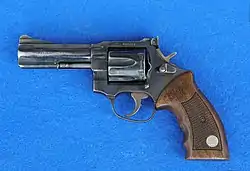| Manurhin MR–73 | |
|---|---|
 Manurhin MR 73 4" in .357 Magnum caliber. | |
| Type | Revolver |
| Place of origin | France |
| Service history | |
| Used by | See Users |
| Production history | |
| Designed | 1972 |
| Manufacturer | Manurhin |
| Produced | 1972–present[lower-alpha 1] |
| Variants | Manurhin MR 88, Manurhin MR 93, Manurhin MR 96, Manurhin F1, Gendarmerie,[2] Sport,[3] Match[4] |
| Specifications | |
| Mass | 880 g (31.0 oz) (2.5") 950 g (33.5 oz) (4") 1,030 g (36.3 oz) (5.25") |
| Length | 195 mm (7.7 in) 205 mm (8.1 in) 233 mm (9.2 in) |
| Barrel length | 2.25 in (57.2 mm) 2.75 in (69.9 mm) 3 in (76.2 mm) 4 in (101.6 mm) 4.25 in (108.0 mm) 5.25 in (133.4 mm) 6 in (152.4 mm) 8 in (203.2 mm) 10 in (254.0 mm) |
| Cartridge | |
| Action | Double-action/single-action |
| Feed system | 6-round cylinder |
| Sights | Iron sights, both fixed and adjustable |

The Manurhin MR 73 is a French double-action/single-action revolver chambered in .357 Magnum and .38 Special. It is manufactured by Manurhin and is available in 2.5", 2.75", 3", 4", 4.25”, 5.25", 5.75", 6", 8" and 10" barrel lengths.
Introduced in 1972, the MR 73 is known for having formerly been the standard issue sidearm of the French National Gendarmerie, as well as for its use by French police tactical units such as GIGN and the National Police's RAID. It has also seen service with military, police, and armed groups elsewhere in the world, most predominantly in the former French colonial empire.
Specifications
Every MR 73 is match grade accurate, shipped with its own factory test target fired at 25 m (27.3 yd). Averaging 15 rounds, no group over 20 mm (0.79 in) diameter with selected ammunition is allowed.
The MR 73 has an adjustable trigger weight in both double-action and single-action modes, a feature found in other high-end revolvers such as those built by Korth and Janz. These adjustments do not alter the strength of the main spring, ensuring reliable primer ignition. This is achieved by use of roller bearings in the trigger mechanism, with extensive hand fitting and polishing of components during assembly. The MR 73 requires more than 12 hours of hand-fitting at the factory, making it about 50% more expensive than competing U.S.-manufactured brands.[4]
The MR 73 can be converted to 9×19mm Parabellum with a replacement cylinder. However, as these rounds are classified under French law as ammunition of war, from the early 1980s onward, it was not officially produced.
Cylinder chambers are finished with an impact process that makes them glass-smooth and extremely hard. The factory proof-fires each cylinder chamber with .357 Magnum ammunition which generates 30% more pressure than the C.I.P. maximum allowable pressure for the Magnum cartridge. The factory guarantees that the cylinder will not burst or show any bulging or deformation with .357 Magnum ammunition developing double the C.I.P. 300.00 MPa (43,511 psi) Pmax piezo pressure, meaning the cylinder can withstand 600.00 MPa (87,023 psi), or 43.5 tons per square inch).
The frame, cylinder and barrel of the MR 73 are made from ordnance-certified steel. Barrels are manufactured by cold-hammering. The rifling is formed during the forging process, eliminating the need to cut rifling as a separate manufacturing step. This creates an extremely hard and microscopically smooth internal barrel surface.[6]
HKS manufactures a speedloader (Model 10A) to use with the .38, .357, and 9mm caliber cylinders.
Variants
A sporting variant called the MR 32 Match is produced in .32 S&W Long. It was first produced in 1985.[7] Other sporting variants are the MR 38 Match chambered in .38 Special and the MR 22 Match chambered in .22 Long Rifle. The Match versions feature only a single-action trigger and have an extended rearward rise. This allows the aiming length to be increased without increasing the total length of the weapon, which would have made it exceed the maximum dimensions authorized in certain competitions.
A variant called the Gendarmerie features adjustable rear sights and larger front sights.
Other variants include the MR 73 Sport, Special Police F1, MR 88, MR 93, and MR 96.
In 2021, Beretta began to import the MR 73 Gendarmerie and the MR 73 Sport into the United States.[8]
Users
Footnotes
References
- ↑ American Gunsmith. 2021. The “Manurhin Candidate”.https://americangunsmith.info/2021/02/05/the-manurhin-candidate/
- ↑ Hogg, Ian (1989). Jane's Infantry Weapons 1989-90, 15th Edition. Jane's Information Group. p. 17. ISBN 0-7106-0889-6.
- 1 2 "Modern Firearms - Manurhin MR-73". Archived from the original on 19 December 2015. Retrieved 11 June 2009.
- 1 2 "recguns Resources and Information". ww1.recguns.com. Retrieved 20 April 2023.
- ↑ "Blue Book Publications - MANURHIN REVOLVERS". Archived from the original on 8 July 2011. Retrieved 30 June 2009.
- ↑ "MR73 RANGE". Archived from the original on 22 February 2001. Retrieved 5 July 2009.
- ↑ McNab, Chris (2004). The Great Book of Guns: An Illustrated History of Military, Sporting, and Antique Firearms. Thunder Bay Press. p. 191. ISBN 1-59223-304-X.
- ↑ Reeves, James (7 May 2021). "The Invincible Revolver Made for Special Forces is Back: The Manurhin MR73". The Firearm Blog. Retrieved 8 May 2021.
- ↑ Magazine LAW and ORDER, July 2009
- 1 2 3 4 5 6 7 8 9 10 Hogg, Ian (1989). Jane's Infantry Weapons 1989-90, 15th Edition. Jane's Information Group. pp. 826–836. ISBN 0-7106-0889-6.
- ↑ Small Arms Survey (2005). "Sourcing the Tools of War: Small Arms Supplies to Conflict Zones". Small Arms Survey 2005: Weapons at War. Oxford University Press. p. 166. ISBN 978-0-19-928085-8. Archived from the original (PDF) on 9 November 2010.
- ↑ "World Infantry Weapons: Niger". 2007–2014. Archived from the original on 24 November 2016.
- ↑ Jones, Richard (2009). Jane's Infantry Weapons 2009-2010. Jane's Information Group. p. 902. ISBN 978-0-7106-2869-5.
Literature
- Revolver Manurhin MR 73 // «Střelecká revue», 11, 1974
